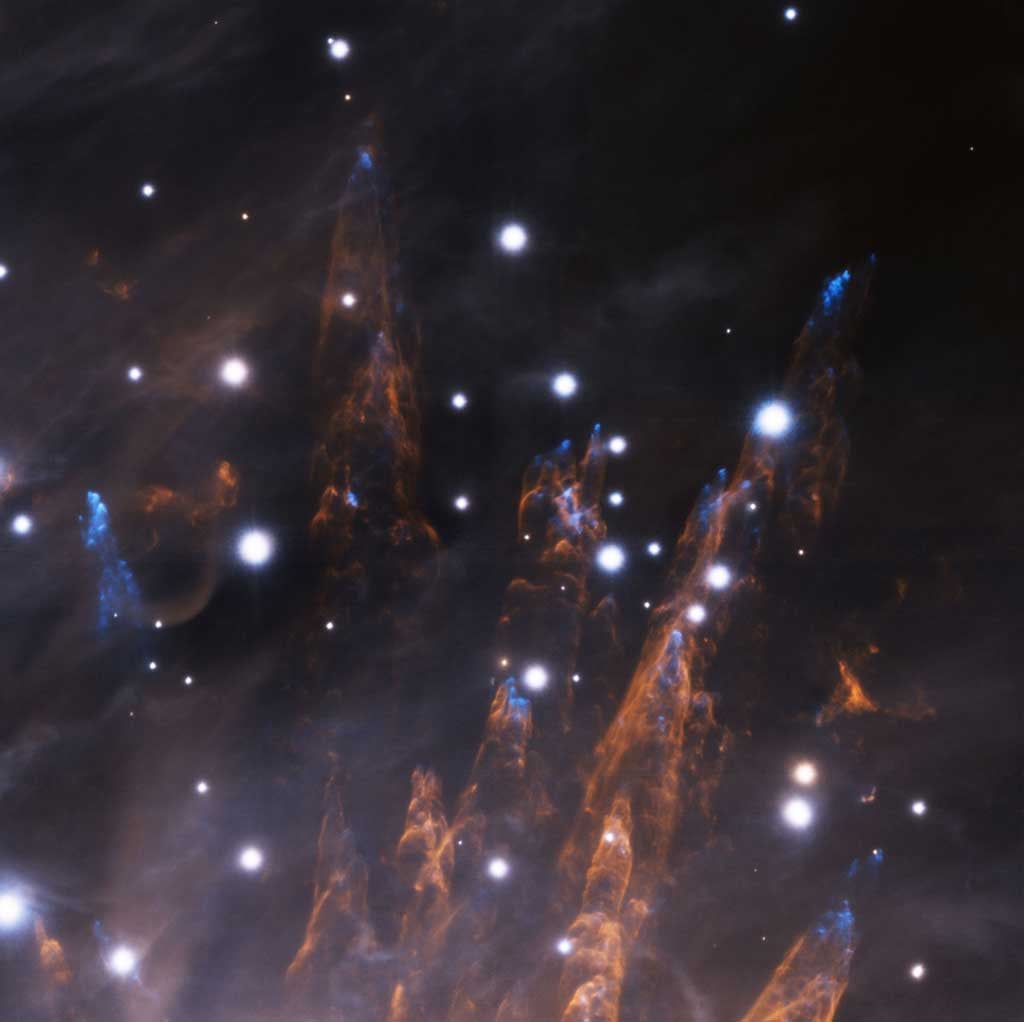“The combination of a constellation of five laser guide stars with multiple deformable mirrors allows us to expand significantly on what has previously been possible using adaptive optics in astronomy,” said Benoit Neichel from the Gemini Observatory in Chile. “For years, our team has focused on developing this system, and to see this magnificent image just hinting at its scientific potential made our nights on the mountain — while most folks were celebrating the New Year’s holiday — the best celebration ever!”
The new system, called GeMS, is installed on the Gemini South Telescope in Chile and is the first of its kind to use laser guide stars and a technology called Multi-Conjugate Adaptive Optics (MCAO) to image the sky. Motivated by MCAO’s potential to produce a significantly larger field of view and more uniform corrections than previous AO systems, former Gemini scientist François Rigaut, now at the Australian National University, first suggested the system’s development at Gemini more than 10 years ago. “It’s a great feeling to see this system on the sky and doing cutting-edge science,” said Rigaut. “When it’s all theoretical, you dream of what it will someday do to improve our vision of the cosmos. An image like this makes it so real — it’s worth all the mental sweat!”
“Adaptive optics allows ground-based telescopes to take full advantage of their large mirrors,” said Gary Schmidt, Gemini program director for the U.S. National Science Foundation. “Gemini’s development of MCAO leads the world, and its fidelity even surpasses that of current — and far more expensive — orbiting observatories for imaging the sky.”
This milestone also bodes well for future generations of large ground-based telescopes. “As telescopes get larger, they look through more and more of Earth’s atmosphere, and this is a problem,” said Gary Sanders, project manager of the Thirty Meter Telescope (TMT) Project. Sanders emphasizes that it is imperative that we find new and innovative ways to solve this problem by removing the distortions caused by the turbulent air overhead. “MCAO is a key technology that makes the next generation of large telescopes, like the TMT, justifiable. It allows us to use the light we collect more efficiently and see the universe more sharply than ever before in human history.”
About five years ago when GeMS was under development and still just a vision for Rigaut and the team, Gemini Observatory released an image of a smaller section of this area of the Orion Nebula known as the “Orion Bullets.” That image demonstrated the power of Gemini’s AO system called Altair, which is still actively used at the Gemini North Telescope. Gemini’s instrument scientist for Altair, Chad Trujillo, points out that in one shot GeMS covers a significantly larger field of view than Altair. “The uniformity and performance across the image is amazing,” said Trujillo. “In this new image, the pixels are 2.5 times finer, and there are about 16 times more of them. Both the correction quality and the field of view are considerably better than the previous generation of AO systems.”
The MCAO advantage
The technology behind MCAO involves the use of multiple laser guide stars (five in the GeMS system) and several deformable mirrors (three in all) to sample atmospheric distortions and cancel them out in real time as imaging data is collected. Using algorithms similar to those developed for medical tomographic imaging, the GeMS MCAO system creates a 3-D snapshot of atmospheric turbulence about 500 to 1,000 times per second. The result is about a 16-fold increase in the patch of sky observed, while providing uniform corrections over the entire field. “This is huge when it’s time for astronomers to reduce their data,” said Adam Ginsburg from the University of Colorado in Boulder. “If the corrections are not uniform across the entire field, it is difficult and sometimes impossible for researchers to compare one part of a data set with another and errors proliferate.”
GeMS, in conjunction with the Gemini South Adaptive Optics Imager (GSAOI), is undergoing commissioning and has obtained some early system verification data. About 80 hours have been offered for the first semester of 2013, and more will be available in the second semester for astronomers in the international partnership through the standard Gemini proposal process.
The Orion Bullets
Discovered in 1983, the Orion Bullets are clumps of gas ejected from deep within the Orion Nebula — located about 1,500 light-years from our solar system. The violence causing this is likely related to the recent formation of a cluster of massive stars with strong winds that can expel gas at supersonic speeds. The bullets — seen as distinctive blue features in the new Gemini image — are actually quite large, about 10 times the size of Pluto’s orbit around the Sun.
As the bullets speed outward, they leave behind distinctive tubular and cone-shaped wakes, which shine like tracers due to the bullets heating of the molecular hydrogen gas in the Orion Nebula. The wakes span much greater distances than the bullets, measuring as much as a fifth of a light-year in length. As Gemini first observed with Altair, the fingerlike wakes also resolve into filaments, which are clearly resolved in the new Gemini GeMS image.










